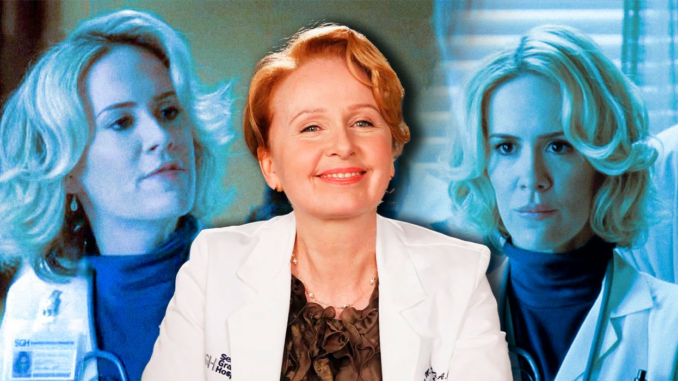
Grey’s Anatomy has always been a show that thrives on complex characters, from the heroic to the deeply flawed. Among these characters, few have sparked as much debate as the controversial figures that audiences either love or love to hate. However, what happens when a lesser-known, forgotten guest star breathes new life into one of these polarizing characters? Suddenly, a character who was once seen as one-dimensional or annoying becomes multi-faceted, intriguing, and worth paying attention to.
In this article, we’ll explore how a forgotten guest star from Grey’s Anatomy played a pivotal role in making a previously controversial character much more interesting. This unexpected character transformation shows the power of a well-timed guest appearance and how it can elevate a plotline in surprising ways.
The Controversial Character: Dr. Miranda Bailey
Dr. Miranda Bailey, portrayed by Chandra Wilson, is one of the most integral characters in Grey’s Anatomy. Throughout the seasons, she has evolved from the tough-as-nails intern director to a multifaceted attending physician and mentor. However, Bailey has not always been everyone’s favorite. In earlier seasons, her tough love approach, strictness, and moments of being overly critical alienated some viewers.
Many fans found her character to be abrasive and difficult to empathize with. Her “pit bull” persona, while effective in the hospital, didn’t always make her a fan-favorite, especially when she clashed with beloved characters like Meredith Grey and Christina Yang. At the time, many felt that Bailey’s character was one-dimensional — a tough, no-nonsense doctor who was hard to relate to.
The Forgotten Guest Star Who Made Bailey More Interesting
Enter Dr. Eliza Minnick, a guest character who would go on to challenge Bailey’s long-held position as the dominant force in the hospital. Dr. Minnick, played by Marika Dominczyk, was introduced in Season 13 as an expert in the field of surgical education. She was brought in as a new attending to oversee the teaching program, which put her at odds with Bailey, who had always been in charge of the interns and residents.
While Minnick’s arrival was initially met with mixed reviews, her presence sparked a dramatic change in Bailey’s character arc. Initially, fans saw Dr. Minnick as just another authority figure trying to take control of Bailey’s beloved residency program, but something unexpected happened: Minnick’s challenge of Bailey’s authority forced Bailey to grow and adapt.

Bailey’s Transformation: From ‘Pit Bull’ to Compassionate Leader
Dr. Eliza Minnick’s introduction and subsequent challenges to Bailey’s leadership played a crucial role in humanizing Bailey’s character. As Minnick criticized Bailey’s methods and openly disagreed with her on several fronts, Bailey found herself forced to reconsider her approach to both teaching and leading her team. This dynamic was essential in showing a side of Bailey that had long been hidden.
A More Vulnerable Bailey
Before Minnick’s arrival, Bailey was the epitome of control. She had earned her “pit bull” nickname due to her no-nonsense approach to being in charge. But Minnick’s challenge forced Bailey to be vulnerable for the first time in years. It wasn’t about being a drill sergeant anymore — Bailey had to ask herself difficult questions about whether her tough-love style was still working in the ever-evolving hospital environment.
In the process, viewers got to see a different side of Bailey — one that was less defensive, more introspective, and ultimately more relatable. She wasn’t just the hard-nosed leader anymore; she became someone who could listen, learn, and change. The tension between Bailey and Minnick helped her realize that her previous leadership style was no longer enough to keep up with the changes in the hospital and the growing needs of her team.
The Power of Conflict in Character Development
One of the most effective ways to make a controversial character interesting is by putting them in a position where they are forced to confront their flaws. Grey’s Anatomy has done this repeatedly with its protagonists, but Bailey’s dynamic with Dr. Minnick brought out a side of her that hadn’t been fully explored.
Through their conflict, Bailey learned to soften her hard edges and approach leadership with more empathy and understanding. Her struggles with Minnick also led to a significant evolution in how she interacted with other doctors, residents, and interns. This transformation made her character far more interesting than the strict, domineering attending she had been in earlier seasons.
Minnick’s Influence on Bailey’s Leadership Style
Minnick’s most significant impact on Bailey was the way she challenged her teaching style. Dr. Minnick, a highly skilled surgeon, had a radically different approach to mentoring than Bailey. While Bailey was more authoritarian in her teaching methods, Minnick advocated for a more collaborative, hands-on approach. This difference in philosophies created significant tension, but it also gave Bailey an opportunity to rethink her own methods.
Adapting to Change
By learning to embrace more flexible and empathetic leadership techniques, Bailey showed that she was capable of evolving. She realized that change was necessary for growth, not just for her personal development but also for the future of the hospital’s medical program. Minnick’s arrival was a pivotal moment in Bailey’s character arc, and it’s something that fans who initially struggled with Bailey could appreciate.
Dr. Minnick’s Departure: The Impact on Bailey
Unfortunately, Dr. Minnick’s time on Grey’s Anatomy was short-lived. After a brief but intense arc, Minnick was written off the show in Season 13. However, her departure didn’t leave the plotlines unresolved — it allowed Bailey to continue her growth as a leader. By the time Minnick left, Bailey had already adapted her approach to teaching, and her interactions with residents and interns were significantly improved.
While Minnick’s departure may have been controversial for some fans, her impact on Bailey’s character is undeniable. Without Minnick’s challenge, Bailey might have remained stagnant as a character, stuck in her strict, rigid leadership role. Minnick’s temporary presence created a lasting ripple effect that resonated through Bailey’s character development, even after she was gone.
The Importance of Guest Stars in Grey’s Anatomy
Dr. Minnick’s role highlights the power of well-executed guest stars in Grey’s Anatomy. While main characters often drive the overarching plotlines, guest stars are instrumental in pushing character development and providing the spark for pivotal moments. Minnick’s short but impactful run on the show is a perfect example of how even a single guest character can leave a lasting impact on one of the show’s most beloved figures.
The introduction of fresh faces is crucial for keeping Grey’s Anatomy dynamic and exciting. Guest stars like Dr. Minnick help to challenge existing characters, force them to confront their weaknesses, and provide new perspectives. Whether they stay for an entire season or just a few episodes, the influence of a strong guest star can transform a character and, in turn, breathe new life into the entire show.
Conclusion: A Transformative Guest Star for a More Interesting Character
Dr. Eliza Minnick’s appearance on Grey’s Anatomy was more than just a simple plot twist — it was a game-changer for Dr. Miranda Bailey. Through their conflict, Bailey’s character was forced to evolve from a strict, one-dimensional leader to a more compassionate and adaptable one. Minnick’s impact helped make Bailey a far more interesting, relatable, and multi-dimensional character.
While Grey’s Anatomy has had many controversial characters over the years, it’s the guest stars like Dr. Minnick who have the power to transform the show’s dynamic and provide the necessary challenges for growth. This unexpected yet powerful influence proves that sometimes, a forgotten character can have the most lasting impact.
FAQs
1. Why was Dr. Eliza Minnick introduced on Grey’s Anatomy?
Dr. Minnick was introduced to challenge Dr. Miranda Bailey’s leadership and teaching methods. Her presence created significant conflict and forced Bailey to reassess her approach.
2. How did Minnick impact Bailey’s character development?
Minnick pushed Bailey to become more empathetic, introspective, and flexible in her leadership, transforming her from a strict, authoritarian figure to a more compassionate and understanding mentor.
3. Why did Dr. Minnick leave Grey’s Anatomy?
Dr. Minnick’s departure was linked to her inability to fully integrate into the hospital’s culture. Her differences with the established staff and Bailey led to her exit.
4. Did Dr. Minnick’s presence improve Bailey’s relationship with the other doctors?
Yes, Minnick’s influence encouraged Bailey to adopt more collaborative and empathetic leadership techniques, which improved her relationships with the residents and interns.
5. Could a similar guest star role have the same impact on other characters?
Absolutely. Guest stars who challenge established characters can play a crucial role in character development, forcing main characters to evolve and adapt in ways that keep the storyline fresh and engaging.
